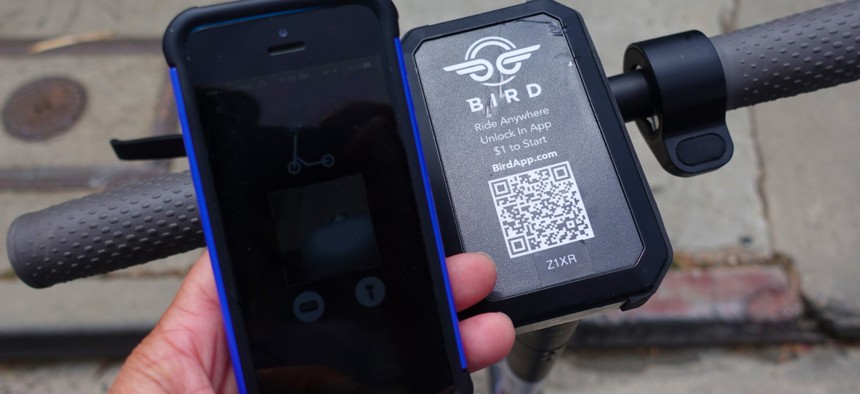How to Make Scooters in Cities Safer

A Bird scooter. Shutterstock
COMMENTARY | Cities should implement sensible regulations and rethink road designs to make scooters a safer transportation option.
It’s been called the “Summer of the Scooter.” Over the last few months, we’ve seen electric scooters that you can rent with a smartphone app everywhere from Washington, D.C. to Denver, Colorado and Raleigh, North Carolina.
Many in these cities are embracing e-scooters as a convenient, affordable, and environmentally friendly way to get around, especially for those short trips that are too far to walk and too short to drive.
At the same time, there are those who see e-scooters as a safety risk to pedestrians and riders. They point to various reports of injured riders, including the tragic death of a woman in Cleveland, who was riding an e-scooter when she was struck and killed by an impaired driver.
Safety on our roads is important, and it must go hand-in-hand with transportation innovation. That is why the public cannot wait to make their streets safer not from e-scooters, but for e-scooters.
Over the past year, we have seen an explosion of new transportation options, including not just scooters but also dock-free bicycles and electric bicycles. This presents a rare opportunity for communities to expand their transportation options beyond just public transit and cars. These new options can address congestion, reduce greenhouse gas emissions, and provide more affordable alternatives than our current transportation offerings. E-scooters can reduce our reliance on cars and expand transportation opportunities for underserved communities that have a hard time getting to work or school or just around town.
However, this opportunity cannot be fully realized until we implement thoughtful, safety-focused changes to the rules and design of our transportation system to make our streets safer for all on the road—both inside and outside a car.
Cars continue to create the most significant crash risks. According to data from the Centers for Disease Control and Prevention (CDC) and the National Highway Traffic Safety Administration (NHTSA), more than 6,000 pedestrians and bicyclists were killed by cars in 2015. It’s also worth noting that the CDC says pedestrians are 1.5 times more likely to die from a car crash than car passengers. Advances in vehicle design and driver education can certainly improve that statistic, but it’s simply not enough to protect the pedestrians, cyclists, and scooter riders with whom cars increasingly share the road.
So what can we do to make our roads safer for all those who use them?
First, cities need to enact sensible rules regulating these new forms of transportation. Just as we have speed limits and age restrictions when driving a car, the safe use of e-scooters and bikes requires a similar approach. For example, companies should adjust e-scooters to travel at a slow maximum speed, such as 15 MPH, and riders should be required to upload a driver’s license.
Second, we must rethink the design of our roads and broader transportation system to account for other vehicles besides cars. It’s time for more protected bike lanes, which can go a long way in shielding bikers and scooter riders from potentially catastrophic crashes. We also should explore dedicating street space for scooter or bike parking on each block.
Finally, we need to realize that there is safety in numbers. The more that people ride on e-scooters and bikes, and the more people drive alongside them, the quicker they will get used to having them as part of the road. This will then give policymakers hard data on how they are being used and the information needed to make smart decisions about deployment and safety.
For our economy and our environment, we must embrace new transportation options. As we do, safety must be paramount, and that means rethinking our streets and mitigating the risks for those around cars, whether you walk, pedal, or scoot.
David Strickland is currently a partner in Venable LLP's Regulatory Group, and Director of the Global Safety Advisory Board at Bird, an electric scooter rental service. He served as Administrator of the National Highway Traffic Safety Administration from 2010 to 2014.

NEXT STORY: What to Include in a National Framework for Self-Driving Vehicles





